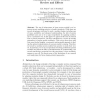Free Online Productivity Tools
i2Speak
i2Symbol
i2OCR
iTex2Img
iWeb2Print
iWeb2Shot
i2Type
iPdf2Split
iPdf2Merge
i2Bopomofo
i2Arabic
i2Style
i2Image
i2PDF
iLatex2Rtf
Sci2ools
74
Voted
BPM
2008
Springer
2008
Springer
Modularity in Process Models: Review and Effects
Abstract. The use of subprocesses in large process models is an important step in modeling practice to handle complexity. While there are several advantages attributed to such a modular design, including ease of reuse, scalability, and enhanced understanding, the lack of precise guidelines turns out to be a major impediment for applying modularity in a systematic way. In this paper we approach this area of research from a critical perspective. Our first contribution is a review of existing approaches to process model modularity. This review shows that aside from some limited insights, a systematic and grounded approach to finding the optimal modularization of a process model is missing. Therefore, we turned to modular process models from practice to study their merits. In particular, we set up an experiment involving professional process modelers and tested the effect of modularization on understanding. Our second contribution, stemming from this experiment, is that modularity appears ...
Related Content
| Added | 12 Oct 2010 |
| Updated | 12 Oct 2010 |
| Type | Conference |
| Year | 2008 |
| Where | BPM |
| Authors | Hajo A. Reijers, Jan Mendling |
Comments (0)

